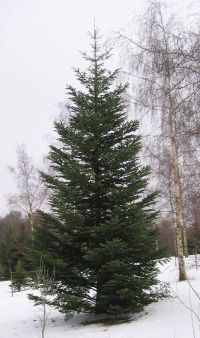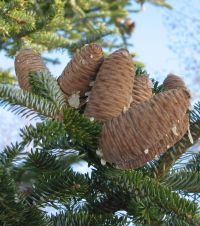Nikko fir - Abies homolepis
English name:
Nikko fir
Scientific name:
Abies homolepis
Family:
Pinaceae (Pine)
Height:
to 30 M
Flowering:
mid May
Range:
Mountains in central and SW Japan
 |
|
 |
 |
The 26-year-old, 9 m tall Abies homolepis in the picture is from Senjogahara, Nikko region, Japan. This tree is found in the Frihedslyst area of the arboretum in squares 2002 position 2508. A map with squares and positions can be found on our homepage under: Digital plant search of the Arboretum.
Plant description:
In spite of the importance for Christmas tree and greenery production, the genus Abies is totally missing from the natural flora of Denmark. All Abies in Denmark have arrived with the help of man. Tor G. Nitzelius from the Gothenburg Botanic Garden in Sweden, was particularly fond of Abies homolepis. He considered it to belong to the elite of the Abies species. Not because it is particularly useful for Christmas tree production but for its use as a park tree. Abies homolepis is reported to be the most resistant true fir to polluted city air. Furthermore, it is has one of the most storm resistant root systems of any conifer and it tolerates a wide range of soil types. Finally, it can produce attractive, blue-violet coloured cones over the entire crown. In contrast, most true fir species only produce cones at the tops of the trees, where they are difficult to see and enjoy. One would think that Abies homolepis would be widely use, but that is not the case. Perhaps this is because of the strong variation among individuals. A seed source producing uniformly good trees in the Danish environment is needed.
Abies homolepis is reported to have been grown in Denmark as early as 1880. It reached our collections as early as 1890 (in the Forest Botanic Garden in Charlottenlund). One specimen from that era still exists but it lost a large part of its crown when a large spruce fell in a storm in January 2005. The oldest specimen in Hørsholm is from 1936. Many plants were introduced in 1977 as a result of a Nordic Arboretum Committee expedition to Japan led by T. Nitzelius. Of the 27 living specimens of Abies homolepis in our collection at Hørsholm, 23 come from this expedition. In addition plants from this expedition were sent from our nursery to other parks and gardens, including: Århus University, Gisselfeld Park, Svaneparken, Sorø Akademihave, and Borsholm Pinet.
Abies homolepis, occurs in the mountains of central Japan and extends to the southwest in mountains on the Island of Shikoku. It typically grows at an altitude above Abies firma and below Abies veitchii. On mountain tops within its elevation range it forms pure stands but is more often in association with Tsuga diversifolia and deciduous broadleaved trees. Sometimes it occurs with flowering Prunus, Magnolia and other broadleaved trees and bushes in charming, natural, woodland-gardens.
Abies homolepis is a moderately fast growing, cone-shaped, evergreen, conifer. The bark is flaky on younger specimens and thus similar to the bark of many species in the genus Picea. Young shoots are light yellow-grey, hairless and notably grooved with a needle in the middle of each ridge between the grooves. The winter buds are typically heavily encrusted with resin, which often turns cloudy-white. The needles are rather stiff, deeply grooved on the top surface, and dark green above but white beneath. They have a tendency to point backwards, especially near the tip of some shoots. They often parted on the upper side on shoots in partial to full shade. The female flowers occur on the upper side of the shoots and in some individuals are especially attractive (see photo). In the mature cones the bracts are hidden beneath the cone scales. The grooves on the young shoots and the flaky bark help to distinguish this species other Abies species Good specimens of A. homolepis are very attractive, even when not producing cones. Furthermore, the ability of A. homolepis to grow on a wide variety of sites, combined with its resistance to air pollution, and the periodic eye catching display of it cones, make it a very useful species for parks and gardens.
References:
Farjon, A. 1990. Pinaceae. Regnum Vegetabile 121, Koeltz Scientific Books. 330 pp.
Lange, J. 1994. Kulturplanternes Indførselshistorie i Danmark. (Introduction History of Cultivated Plants in Denmark). Jordbrugsforlaget, Frederiksberg. 458 pp.
Langschwager, L. 1997. Havens Planteleksikon, Træer og Buske; Bind I Det Danske Haveselskab Lyngby. 360 pp.
Liu, T.-S. 1971. A monograph of the genus Abies. National Taiwan University, Dept. of Forestry, Taipei. 608 pp.
Mitchell, A. & Ødum S. 1983. Træer i Nordeuropa (Trees in Northern Europe). Gads Forlag, Copenhagen, pp. 413pp.
Rushforth, K. 1999. Trees of Britain and Europe. Harper Collins Publisher. 1336 Pp.
